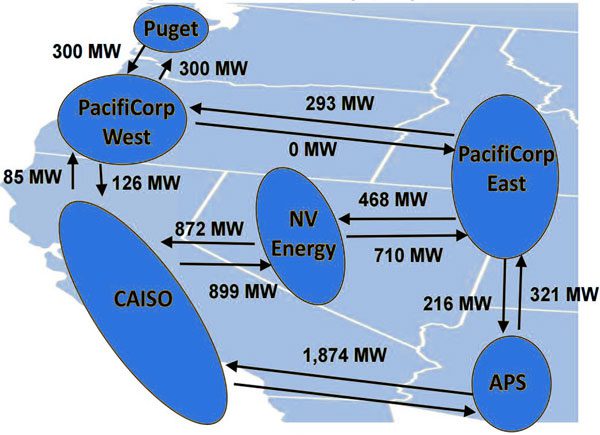CAISO Monitor Proposes Fixes for EIM Market Power Concerns
CAISO’s internal Market Monitor is proposing new enforcement measures to address market power concerns in the Energy Imbalance Market — an effort that could help participants win market-based rate authority in the West’s only real-time energy market.
The Monitor’s efforts come in response to FERC rulings limiting nearly all of the EIM’s current participants to transacting at cost-based rates — the result of the commission’s ongoing concerns about manipulation in the nascent market.
“We’ve been working with the [EIM] participants and the ISO to address the various concerns that FERC articulated so [participants] could refile and get market-based rates,” Eric Hildebrandt, director of CAISO’s Department of Market Monitoring, told a Nov. 30 meeting of the EIM’s governing body.
Hildebrandt pointed out that FERC now requires all prospective EIM members to file for market-based rate authority before joining the EIM — even if those entities already exercise that authority in the rest of the West.
“At the Market Monitor, we actually think it’s a very good thing — as long as the conditions are competitive — to have the full flexibility of bidding that is afforded entities which have market-based rates,” Hildebrandt said.
That flexibility has so far been elusive for three out of the four current EIM members.
Denials
FERC denied NV Energy and PacifiCorp — both subsidiaries of Warren Buffet’s Berkshire Hathaway Energy — EIM market-based rate authority in a November 2015 ruling that cited the companies’ failure to employ sufficient tests demonstrating their inability to wield economic power in their portions of the imbalance market (ER15-2281). The commission rejected Arizona Public Service in an August 2016 ruling (ER10-2437).
In both instances, the commission said it could not rely on CAISO’s market monitoring and mitigation to sufficiently address market power concerns in the EIM. All three utilities were invited to reapply for market-based rate authority once they could provide an additional 12 months of operational data demonstrating whether or not they possess market power.
FERC is concerned about the potential for EIM participants to engage in physical or economic withholding of generating resources in areas of the EIM subject to transmission constraints — wide areas dominated by generation owned by EIM members themselves.
Physical withholding can involve a supplier not bidding lower-cost resources into the market in order to allow higher-cost units to set clearing prices. This risk arises from the fact that the EIM has no must-offer requirement.
Economic withholding occurs when a unit bids into the market above its marginal costs in order to elevate the market price.
Monitor’s Proposals
CAISO has attempted to address this risk through automated bid mitigation procedures that kick in when transmission congestion limits supply into an EIM area. But FERC expressed concern that the ISO might not enforce the market constraints required to trigger mitigation.
To address the commission’s concerns about physical withholding, the Monitor suggests that the ISO improve the EIM’s outage reporting rules by logging when plant outages are submitted by market members for non-physical reasons. In short, the ISO must have more visibility into EIM outages, Hildebrandt said.
To counter economic withholding concerns, the Monitor recommends that the ISO step up enforcement of local market constraints in specific EIM areas and provide FERC an explanation when it decides not to enforce them.
Hildebrandt said the Monitor will heed a commission request that it comment on market-based rate authority proceedings, something the department hasn’t done in nearly a decade, he noted.
Puget’s Success
Lessons can be learned from Puget Sound Energy’s successful effort to obtain market-based rate authority in the EIM, Hildebrandt said (ER10-2374).
The commission determined that Puget provided sufficient evidence that its limited link to other EIM areas would not become constrained frequently enough to create a submarket requiring specific measures to mitigate market power.
A significant factor in gaining approval: Puget’s commitment to providing 300 MW of firm transmission to the market at all times. Other EIM members committed a “less certain” volume of transmission to the market, Hildebrandt said.
“I think the key there is the amount of potential transmission,” Hildebrandt said. “If they can satisfy to FERC that it’s going to be offered or available all hours, that would seem to play a big role.”
Hildebrandt said Puget’s approach could provide a template for how the ISO can work with other members to help them win FERC approval.
The EIM’s continued expansion should go a long way in assuaging FERC’s concerns about the interplay between transmission constraints and local market power, according to Hildebrandt. The Monitor’s own analysis indicates that the addition of NV Energy a year ago created enough additional transfer capacity to ensure competitiveness in all EIM balancing authority areas during nearly all hours.
That additional capacity is translating into increased flows between EIM areas, making the market more competitive, Hildebrandt said.

Map illustrates average transfer capacity throughout the Energy Imbalance Market since Arizona Public Service and Puget Sound Energy joined the effort in October. | CAISO
“Now with multiple connections between the ISO and the EIM, you really have to have congestion on multiple constraints at the same time to isolate any one area,” he said. If congestion occurs at one constraint, energy can be scheduled around it to supply the affected area.



